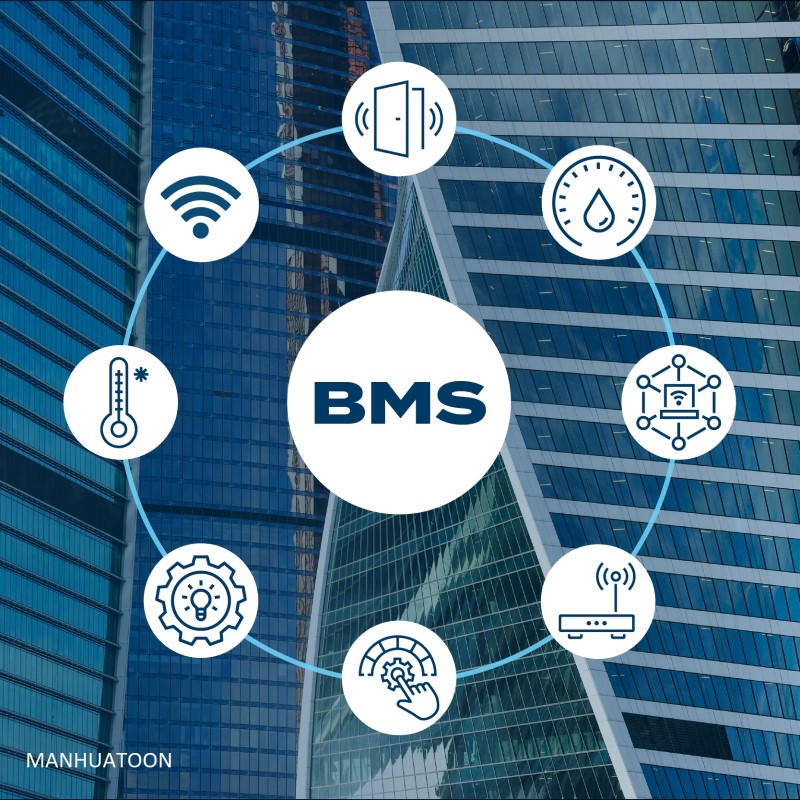Naturally, property owners want to minimize running expenses while enhancing tenant security and comfort. By using a cloud-based building management system it is possible to create a smart building and allow property owners to find hidden opportunities. Let’s learn about the concept of building management system with manhuatoon before going deeper!
What is a building management system (BMS)?
Building Management System (BMS), also known as Building Automation System (BAS), is a control system that can be applied to manage and monitor the mechanical, electrical, and electromechanical functions inside a building. Electricity, heating, ventilation, air conditioning, physical entry control, pumping stations, elevators, and lighting are a few examples of these services.
The most basic components of a BMS are software, a database server, and intelligent devices connected to an Internet-capable network. The BMS stores the data in a database after receiving it from smart sensors placed throughout the structure. A sensor will generate an alert from the BMS if its data is reported outside of the predetermined parameters.
A structure is considered smart if it is connected and managed in this way. Complex IoT network monitoring is necessary for smart buildings to operate effectively in order to manage the building system. In order to become a part of a smart city, a smart building can also be readily integrated with other structures.

Why Your Building Needs a Cloud-Based Management System?
Consider a scenario in which you need to manage the settings at your commercial property while you are halfway across the globe. You can watch and manage your building using a cloud-based system from a computer or mobile device located anywhere in the world.
It is advantageous to be able to use a BMS for efficient monitoring and control when a company operates around the clock. But this device is more than just a commercial space remote control.
A cloud-based building management system is being tested by Cube Controls to assist customers in making the most of these features and enhancing staff well-being while lowering energy consumption. Using a cloud-based system will enable you to use more useful BMS apps.
High-level analytics reporting is also completely automated by the cloud-based BMS. You save money because you don’t have to pay outside companies to evaluate the efficacy of your building. Your system’s external monitoring is an unnecessary expense.
The advantages of a cloud-based building management system don’t end there. One of these advantages is the ability to evaluate energy costs and compare performance across locations by looking at individual or overall building operations.
Automated alerts can be triggered by unforeseen events and abnormal conditions, giving you the time you need to respond quickly and address problems. Additionally, if there is a problem with the passing, this system instantly cuts off and displays the equipment failure. You can perform maintenance in this manner before anything goes awry.
Information sharing is made simpler by the Cloud, which also enables “bottom-up” answers. Reusable resources, such as local system management programs, can be kept in a central library that is accessible from anywhere, preventing the need to constantly reinvent the wheel. When decision-makers, from neighborhood maintenance to company planners, are kept informed, overall building services improve.
How to Implement a Cloud-Based Building Management System
1. Site Logistics
Determining the infrastructure required to link all of your sites to the Cloud could be the first obstacle you face. You might need to add lighting controls with a scheduler or install HVAC controls to allow remote monitoring. You might even want to include a light level sensor, which reduces energy consumption by adjusting the amount of light produced in accordance with the amount of daylight.
2. Budget
Organizations frequently fail to recognize the advantages a cloud-based system can offer and allow financial concerns to stymie project progress before it even gets started. Focus on a few crucial locations first rather than feeling overwhelmed by the idea of implementing an organization-wide system. After that, you can extend project plans to include other facilities as funding becomes available. Simply connect each new website as it is updated to the cloud and then to your analytics tool.
3. Security
Every company, including yours, should be concerned about security. Compared to most internal IT systems, cloud computing can offer a more secure and affordable setting. This is as a result of centralized data management, storage, and supervision. Even some cloud services give the same technology as secure banking.
There are two varieties of clouds: public and private. The open Internet is used by the public cloud, which allows customers to share resources. Each client has access to specific resources through the private cloud. However, based on what the provider offers, both options may be very secure.
Care is needed as not all Cloud-based management systems are created equal. While personal information is not transferred in building management applications, some building information (such as security status or occupancy status) may be considered sensitive. Use a reputable Cloud provider who can address any security concerns you may have.
Final Words
A cloud-based building management system can help administrators more efficiently manage a building’s operations. By providing a centralized platform for managing all building systems, this system can help save time and money while improving the overall quality of building operations.
